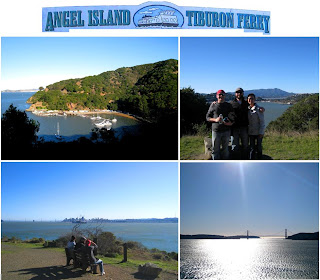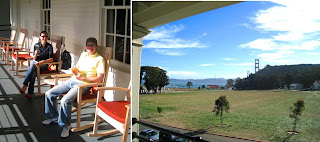When I go to Angelino for lunch I love to sit at the bar, which is tended by either Sal or Ted, and which commands a nice view of the room and the Bay beyond. In addition, if they have some time, either Pasquale or his wife, Donna, will stop by for a chat.
My favorite dish at Angelino is their Linguine alla Pescatore, which is served with a wonderful spicy tomato and fish sauce including shrimp, scallops, clams, mussels, squid and chunks of fish. The pasta is also cooked perfectly al dente, which adds a great deal to the dish. A glass of the Vermentino from Sardegna is the perfect accompaniment for the dish.

 The other day when I was at Angelino for lunch I was a bit hungrier than usual and decided to also have a bowl of their soup of the day, which turned out to be a Tuscan soup made with kale, beans and farro. It was absolutely fantastic – both great flavor and a very interesting texture provided by the slightly chewy farro, a grain I had never had before. I asked Pasquale about the ingredients, which unexpectedly led him to burst out laughing. It turns out I had confused the Italian for Lacinato kale (cavolo nero) with that for a black horse (cavallo nero). Something to watch out for in the future.
The other day when I was at Angelino for lunch I was a bit hungrier than usual and decided to also have a bowl of their soup of the day, which turned out to be a Tuscan soup made with kale, beans and farro. It was absolutely fantastic – both great flavor and a very interesting texture provided by the slightly chewy farro, a grain I had never had before. I asked Pasquale about the ingredients, which unexpectedly led him to burst out laughing. It turns out I had confused the Italian for Lacinato kale (cavolo nero) with that for a black horse (cavallo nero). Something to watch out for in the future.
 When I got home that day I was able to find a recipe online for Farro Soup with Kale. A few days later I used that recipe as a starting point for my own attempt at the dish as follows:
When I got home that day I was able to find a recipe online for Farro Soup with Kale. A few days later I used that recipe as a starting point for my own attempt at the dish as follows:
INGREDIENTS (serves 8): ~ 6 ounces whole grain farro (Note: I used a brand called Bartolini from Umbria, which was “semipearled” (i.e. perlato), a term which apparently indicates that the hull has been removed from the grain. I read in one place that if the hull has been removed, there is no need to pre-soak the grain before using it. However, I did soak it overnight..
~ 1/2 pound borlotti beans (Note: Borlotti beans, also known as roman beans or romano beans, are a variety of cranberry bean bred in Italy to have a thicker skin. Borlotti/ cranberry beans originated in Colombia where they were known as cargamanto. The bean is a medium large tan bean, splashed with red/black to magenta streaks. I used a brand of dried beans called Riso Carena from Pavia in Lombardia))
 ~ 1 can (28 oz.) whole, peeled tomatoes, including the juice (I used La Primavera brand from Napoli imported by AG Ferrari)
~ 1 can (28 oz.) whole, peeled tomatoes, including the juice (I used La Primavera brand from Napoli imported by AG Ferrari)
~ 1/3 lb pancetta, coarsely minced
~ 2 cloves garlic, minced
~ 1 medium onion, minced
~ 1 carrot, minced
~ 1 8-inch rib of celery, minced
~ 2 bunches (about a pound) of Cavolo Nero kale (also called Lacinato Kale, Tuscan Kale, Black Kale or Dinosaur Kale), stems removed and coarsely shredded
~ 1 qt. chicken stock (I used Pacific Natural Foods brand)
~ Parmigiano-Reggiano cheese
~ Olive oil
~ Salt & pepper to taste
PREPARATION:
The night before you are doing the cooking soak the farro and, assuming you are using dried beans, the beans.
Before starting the preparation of the soup, cook the soaked beans until close to being done. I put them in a pot with water to cover by about 2 inches, brought it to a boil, and then simmered the beans for about 2 hours.When the beans are ready, blend about 2/3 of them in a blender. Put the blended beans, the remaining whole beans, the water the beans were cooked in, and the soaked farro (drained), into a soup pot.
Sauté the minced pancetta in a large frying pan over a medium flame. When done, remove to a dish and hold.
Sauté the garlic in the pancetta fat over a low flame (you may need to add a bit of olive oil). When just translucent (but not browned), remove it to the same plate as the pancetta.
Sauté the onion, celery and carrot (i.e. to make a basic soffritto) in 1/3 cup olive oil over a low flame. Once the onions are translucent, stir in the tomatoes (including the juice from the can), add back the pancetta and garlic that was set aside, and simmer for a couple of minutes more. Transfer the onion/ celery/ carrot/ garlic/ pancetta/ tomato mixture to the soup pot, and add the kale and chicken stock. Bring to a boil, and then lower the heat and simmer for 2 hours, stirring frequently. Should the soup become too thick add water. Check the seasoning towards the end of the cooking time.
Serve with grated Parmigiano-Reggiano cheese.
REFLECTIONS:
The soup was very good the first time I made it – here it is:

The one major deficiency I found my soup had by comparison to the Angelino version was that the farro in my soup was too soft. The farro in the Angelino soup had a definite chewiness to it which mine lacked. It may be that it should not be soaked as long, or perhaps I should try to use unhulled farro (i.e. not “perlato”).
Also, although it was not bad, the broth in my version had more of a tomato flavor and red color to it than the Angelino version. The next time I plan to omit the juice from the canned tomatoes. Obviously using fresh tomatoes would be best, although this is a winter dish.
I think the soup would also be enhanced by being served with some garlic-rubbed bruschetta (toast, ideally made with ciabatta bread) on the side.
The overall preparation/cooking time (from the time I started the pre-cooking of the beans to the time the soup was served) was about 4 ½ hours. The actual ingredient preparation – primarily the mincing and chopping of ingredients – took about an hour.
I definitely plan to make this again.
 This was one of the side dishes that we prepared during a February 2009 cooking class at Cavallo Point led by Judy Witts Francini. Judy has a description of this dish, and the use of beans in general in Tuscan cuisine, on her Divina Cucina website. Here is an extract:
This was one of the side dishes that we prepared during a February 2009 cooking class at Cavallo Point led by Judy Witts Francini. Judy has a description of this dish, and the use of beans in general in Tuscan cuisine, on her Divina Cucina website. Here is an extract:

































































